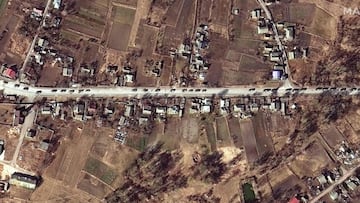Have Ukrainian jets attacked 40km Russian military column?
As President Vladimir Putin pushes on with the invasion of Ukraine, his huge convoy of military might is making slower than expected progress towards Kyiv.

Despite Russian president Vladimir Putin's latest claims that his invasion of Ukraine is "strictly in accordance to the plan and schedule," many eyes have been focused on the massive military convoy that has been making its way towards the country's capital, Kyiv. As it turns out, it's not only eyes that have been zeroing in on this target.
Did Ukraine destroy Russian convoy?
Russian authorities maintain their stance that its actions in Ukraine are a "special operation" not designed to occupy territory but to destroy its neighbour's military capabilities and capture what it calls dangerous nationalists. Don't ask them to provide any real evidence for this, though. Propaganda doesn't work like that.
There is no doubt that Ukraine's military is dwarfed by that of its powerful neighbour - something we assessed earlier in the conflict - but resistance in the first week has slowed Russia's progress, particularly in urban areas. It's incredible how resilient a people can be when they have a real cause to fight for.
Russia has, of course, made significant gains, and has captured one Ukrainian city so far - the southern Dnipro River port of Kherson - and has bombarded others with increasing intensity, including Kyiv and the country's second city Kharkiv.
But that giant column of Russian armour, which looked so threatening in the last couple of days, has stalled as it approaches Kyiv from the north, delayed by resistance, as well as mechanical failures and congestion, according to the British defence ministry. And that makes it a relatively sitting duck for the Ukranians.
More on the Russia-Ukraine conflict:
One thing to note about the column is that there have been various conflicting reports about the length of it. I've seen 40 kilometres cited, as well as 64 km and 18 km, among others. The key thing to remember is that it is a moveable beast, and depending on elements such as fuel supplies or road space, the dimensions are naturally going to change. One thing that is not in doubt is that it is a mighty force, although some suggestions are that it is made up of a number of smaller groups, combined due to these problems in advancing at pace.
Which brings us to the attacks. As reported by the head of Ukraine's defense intelligence agency, Ukraine's armed forces have been firing at that long line of Russian troops.
“We are striking the enemy’s columns,” Brig. Gen. Kyrylo Budanov told Military Times in an exclusive interview on Wednesday. “We burn many columns of the enemy.
“My intelligence officers and agents are directing and calling the strikes,” he said.
The strikes, he said, are being conducted by Ukraine Su-24 and Su-25 fighter jets, artillery and missile barrages.
Ukraine's 'hedgehogs' face up to Russian tanks
Hundreds of thousands of people have fled the violence and crossed into neighbouring countries. Men of fighting age are prevented from leaving Ukraine.
And as Russian troops closed in Kyiv on Thursday, a muddy construction site in a local neighbourhood was teeming with workers and welders of the KAN real estate developer. Instead of homes and offices, however, they were making giant, metal anti-tank barricades known as "hedgehogs", and smaller spiked barriers aimed at stopping wheeled vehicles. After Russia invaded Ukraine on 24 February, KAN, a large local property company, reinvented itself to help the defences of the city of 3.4 million people.
Zakhar, a foreman, picked up the phone and started calling the company's construction workers who had remained in Kyiv. Almost everyone volunteered to stay and contribute, he said.
"We build things. We do not know how to fight, but we knew we could be useful," Zakhar said. A few metres away sparks flew as builders cut through and welded together large metal beams. It is another example of how Ukrainian civilians are supporting regular troops as they try to repel Russia's advance, including through civil defence units and independent militia that have formed across the country.
Boxing champ Klitschko ready to block, parry and counter
On 25 February, Kyiv's mayor and boxing champion, Vitali Klitschko, said the city "has gone into the defensive phase."
Heavy equipment was brought in to build concrete checkpoints, blocking positions and bunkers inside the city and along all major roads and in the suburbs.
At KAN, workers cut long pieces of girder using blow torches and angle grinders, welding them together into triangular barriers used to bolster fortifications and slow the movement of tanks and tracked armoured personnel carriers.
Oleksandr Bodyuk, the company's deputy director, said workers were also using reinforcing bars and girders salvaged from construction sites to produce spiked, movable defences against wheeled vehicles, including trucks.
So far the makeshift factory, which started operating this week, has produced 110 large hedgehogs, including 40 in the fist 12 hours, Bodyuk said, adding that the company runs other similar sites in the city.
"We have demands from many places for these types of blocking devices, we deliver them wherever they are needed in the area ... subcontractors and friends are providing transportation for the products and the material," he said.
Andriy Kryschenko, Kyiv's deputy mayor who was wearing military fatigues, said many similar firms and workshops had adapted to produce hedgehogs, concrete barriers and other defences.
He added that tens of thousands of people in Kyiv had received weapons and many more were waiting at enlistment and recruitment offices. The city hall was also supporting Territorial Defence units and troops at the frontline, Kryschenko said.
At the construction site, Serhiy Serdyuk, a grizzled welder in his 50s, said workers were ready to take up weapons and join the fight.
"If we have to, when the materials run out, we will make spears and we will throw those spears at them."





